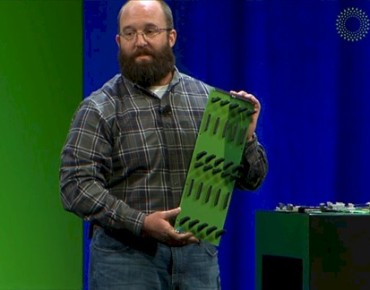Calxeda Adds Top Facebook Hardware Exec to Board

ARM server chip maker Calxeda has landed a heavy-hitter in the open source hardware effort to its board of directors – someone who also makes hardware decisions at one of the big hyperscale datacenter operators, too.
It is a pretty big deal that Frank Frankovsky, who is vice president of hardware design and supply chain at Facebook and who is also chairman of the Open Compute Foundation, has joined the board of directors at the Calxeda. But it is important to not jump the gun and start thinking that this is an endorsement of ARM-based servers by Facebook.
Just like most open source software developers have day jobs and then side projects they work on, Frankovsky has a day job and a hardware development project. What can be honestly said is that an endorsement by the Open Compute Project for what Calxeda is doing could lead to sales at hyperscale datacenter operators like Facebook, and anything that gives Calxeda insight into what their requirements are will help the chipmaker get the right products into the field to get those endorsements.
"The Calxeda team has a terrific vision for the role of ARM in the datacenter, and they have the talent, the technology, and the commitment to openness required to execute on that vision," Frankovsky said in the statement. "I'm thrilled to have an opportunity to collaborate with their executive team and the rest of the board more deeply as they work toward 64-bit fabric and beyond."
Calxeda is one of the first chip makers to commercialize ARM-based processors specifically for server workloads. As EnterpriseTech has previously revealed, Calxeda has big plans to extend the capabilities of its ARM chips and its Fleet Services interconnect in the next couple of years, with the goal of being able to connect up to 100,000 single-socket ECX server nodes together into a fabric without any top-of-rack-switches.
Calxeda's focus on low-power computing and integrated networking has no doubt gotten the attention of Facebook, but the social network is always very careful to not make any kinds of endorsements for a particular vendor's products or strategies. In fact, the statement announcing Frankovsky's appointment to the Calxeda board does not mention his role overseeing hardware at Facebook.
When Frankovsky does show off particular bits of hardware design, he does it through the summits hosted by the Open Compute Project, which he launched with a bunch of Facebook engineers back in April 2011. That was when Facebook open sourced the rack, server, and datacenter designs used in its Prineville, Oregon facility, setting them free for others to use and modify as they see fit. The Prineville datacenter was the first facility that Facebook designed and built itself. The company now has two others – one in Forest City, North Carolina and another in Lulea, Sweden – and a fourth is being built in Altoona, Iowa.
At the Open Compute Summit in January, Frankovsky showed off a Calxeda system board nicknamed "Knockout," which was designed using the quad-core, 32-bit ECX-1000 to provide auxiliary processing power in an array of machines set up to be a clustered file system. The idea is to be able to run a single X86-based machine as a head node in a cluster file system such as Lustre or Gluster and use cheaper, lower-powered ARM nodes as storage node controllers.
Moreover, an ARM-powered cluster based on the Knockout boards could be used to run the Ceph distributed object store or any number of NoSQL data stores, and again the idea is to distribute the processing capacity more uniformly over the storage media as well as using the Fleet Services interconnect to allow data replication, compression, encryption, and snapshotting across the cluster without relying on hefty X86 nodes and top-of-rack switches. The integrated Calxeda fabric would handle all of the east-west traffic in the storage cluster and the top-of-rack switch would just handle all of the north-south traffic linking the cluster to servers.
Calxeda, which joined the Open Compute Project in January, is also one of the chip makers that is going to support OCP's proposed "Group Hug" microserver form factor and interconnect, which Frankovsky also showed off at the summit earlier this year. The Group Hug backplane uses PCI-Express x16 slot mechanicals to hook microservers together, and in the initial design that OCP revealed at the summit up to ten microserver cards could be plugged into a backplane that is skinny enough to fit three Group Hugs side-by-side in a normal rack. That works out to thirty single-socket servers in one enclosure.
Frankovsky was one of the key engineers who helped set up the Data Center Solutions business at Dell, which is the part of the IT supplier that makes custom gear for hyperscale datacenter customers. In fact, Facebook was one of the early and high-volume customers for the DCS unit. In 2009, Facebook hired Frankovsky when it decided to design its own machines and open source them.
Calxeda was founded in January 2008 and was out the door early with a server-specific ARM chip design. The EXC-1000 launched on November 2011. It is based on the 32-bit Cortex-A9 design from ARM Holdings, but includes systems management and networking features wrapped around the chip. ARM servers are just starting to attract real-world customers, just as are Intel's low-powered Atom chips. Both Calxeda and Intel are seeing so-called "cold storage" applications for their respective chips. With cold storage, you have the cheapest, slowest, lowest-powered components you can put together to make a storage array because the data on them – such as an archive of Facebook photos – is accessed so infrequently that storing that data on a regular disk array would be too costly.











